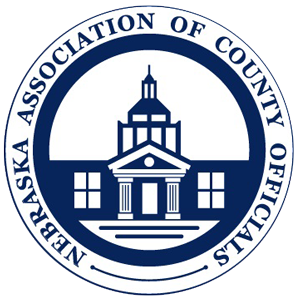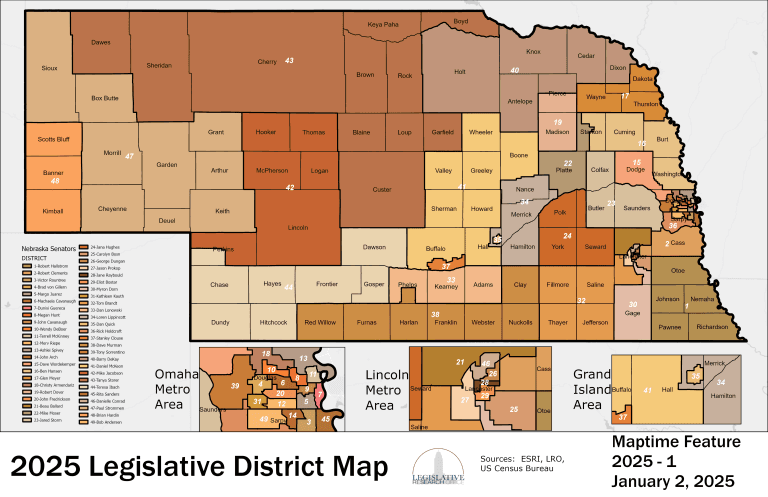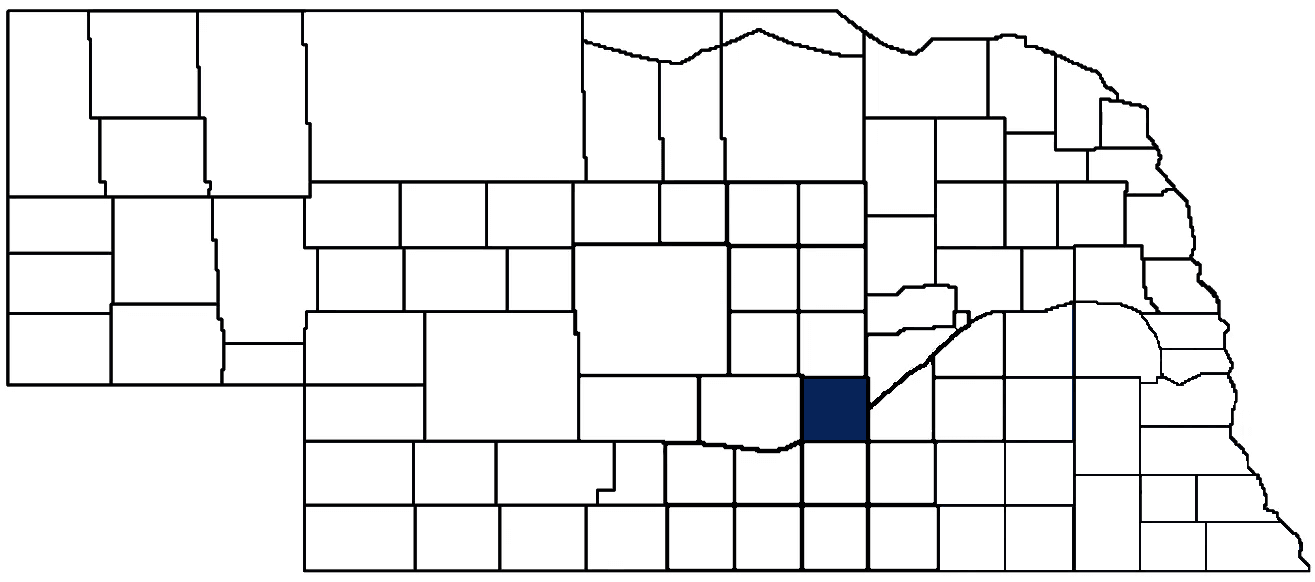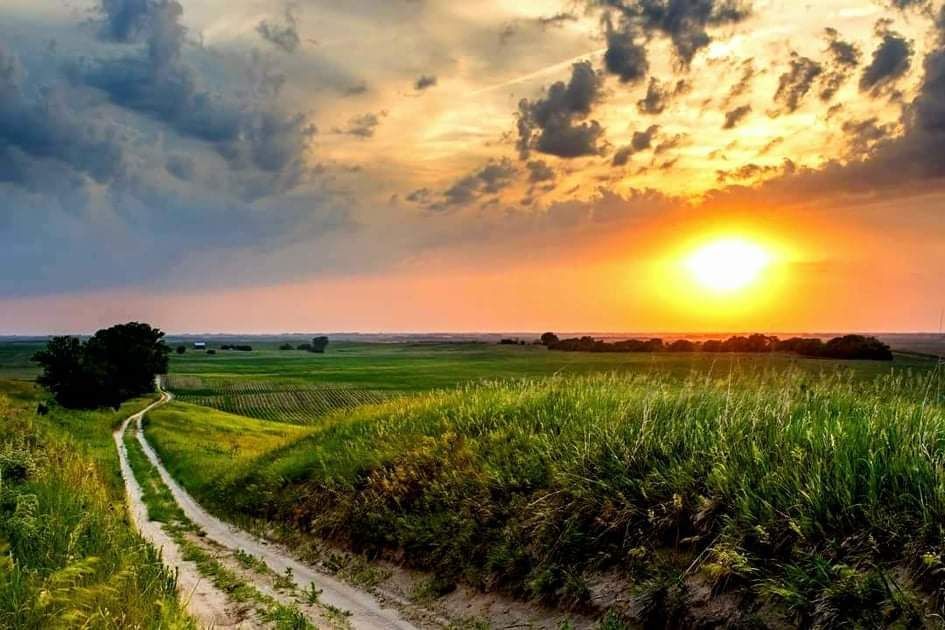- General Info
- Demographics
- Education and Employment
- Valuation and Taxes Levied
- State Senators
- History
- County Programs
- Other Information
Communities and Development
Hall County Seat: Grand Island
Total County Population: 62,895
- Cities (pop. & class): Grand Island (53,131 • 1st Class), Wood River (1,172 • 2nd Class)
- Villages (pop.): Alda (647), Cairo (822), Doniphan (809)
- Unincorporated Pop. (% of total county pop.): 6,314 (10%) 2020
Land Development (% of total land in county):
- Agriculture: 82%
- By method: Irrigated (row crop/grain/forage) (63%), Pasture (pure grassland) (14%), Dryland (row crop/grain/forage) (5%) • Neb. Dept. of Rev. - total equals agriculture's %
- By commodity: Corn 51%, Livestock (grassland) 15%, Soybeans 15%, Alfalfa 2% • USDA - equals agriculture's % plus some wetlands (7%) and minus public grassland/wetlands and reserve
- Residential, Commercial, Industrial, Conservation Reserve & Exempt (combined): 18% 2022
County Offices
Courthouse Address and Hours:
200 S Sycamore St
Grand Island, Nebraska 68801
M-F 8:30 am - 5:00 pm
County Board Chairperson: Ron Peterson
Complete list of county board members
County Board Meetings: Tuesday (Bi-weekly)
View the County's Government Maps
NACO District: Central
Click for a live look at Hall County (south of Grand Island)
General
Population: 61,979
Land area (sq. mi.): 546.39
Population per square mile: 115.1
Race and Age
Race 2020
White: 62.7%
African American: 2.9%
American Indian: 0.3%
Asian: 1.1%
Hispanic: 30.5%
Native Hawaiian and Pacific Islander: 0.0%
Two or More Races: 2.2%
Age 2020
0-17: 27.5%
18-64: 57.1%
65+: 15.4%
Households
Total households: 23,805 2020
With one child: 3,720 2022
With 2+ children: 4,680 2022
With seniors (65+): 5,210 2022
Socioeconomics
Median household income: $79,145 2023
% of Population in Poverty: 11.5% 2023
# of Housing Units: 25,159 2020
Owner-occupied rate: 60.7% 2020
Median home price: $224,890 Q4 2024
2024 building permits for detached single family homes: 104
2024 building permits for non-detached housing units: 142 (townhouse, duplex, or apt. unit)
Technology
Access to broadband (100 Mbps via fiber or cable modem): 91.6% 2021
Sources: National Association of Realtors, Nebraska Department of Revenue, Nebraska Legislature, Nebraska Library Commission, U.S. Bureau of Economic Analysis, U.S. Census Bureau (building permits), U.S. Census Bureau (demographics), U.S. Census Bureau (municipalities)
Employment, Schools, and Child Care
Unemployment rate: 4.9% March 2025
County Employment Website: https://www.hallcountyne.gov/
High school graduate or higher: 85.2% 2020
School Districts: Adams Central Public Schools, Aurora Public Schools, Centura Public Schools, Kenesaw Public Schools, Doniphan-Trumbull Public Schools, Northwest Public Schools, Shelton Public Schools, Wood River Public Schools
Bachelor's degree or higher: 21.2% 2020
Community College Service Area: Central Community College
Countywide child care capacity: 76 providers; 2,484 children 2024
Find child care: For a list of child care providers in your zip code, visit Nebraska DHHS or the Nebraska Resource and Referral System.
Hall County Economy
Annual Gross Domestic Product (GDP): $5,109,690,000 2023
Nonfarm Small Business Receipts: $656,870,263 2022
Nonfarm Wage Income: $1,436,155,000 2022
Farm and Ranch Commodity Sales Receipts: $395,913,000 2022
Farm and Ranch Operations (Non-Sales) Receipts: $17,813,000 2022
- For components of nonfarm small business receipts, nonfarm wage income, and farm & ranch commodity sales and operations receipts, see "Notes" below.
Ethanol Plants (annual production capacity): Green Plains (124 million gallons)
Grain Elevators by Location (bushels capacity):
- Grand Island: Aurora (3,350,000), Viterra (778,000)
- Prosser (Hayland): CPI (9,039,000)
- Shelton: Cargill (4,076,000)
- Wood River: CPI (2,077,000), Green Plains Grain Warehouse (3,293,000)
- (1 bushel = 56 lbs. corn/sorghum, 60 lbs. soybeans/wheat; % max. moisture = 18% beans, 15.5% corn, 14% sorghum/soybeans, 13.5% wheat)
Railroad Miles: 119.57 main, 58.79 side
- Places with Railroad Service: Alda, Cairo, Grand Island, Hansen, Shelton, Wood River
Grain Co-ops and Purchasers: Aurora Cooperative, CPI, Green Plains
Local Grain Market: Click for today's grain prices in Hall County
Cattle Producers: 202
Crop Producers: 393
Dairy Producers: 1
Farmers Markets:
- Grand Island Farmers Market (July - October, Daily 8 AM - 6 PM)
- The Local Farmers Market (Cairo) ( May - October, Fridays 5 - 7 PM and Saturdays, 9 - 11 AM)
Electricity Providers: City of Grand Island, City of Wood River, Dawson PPD, Nebraska PPD, Southern PPD
Irrigation and Drinking Water
Rural Irrigation Wells: 3,800 2024
Rural Livestock Wells: 152 2024
Rural Commercial/Industrial Wells: 54 2024
Rural Drinking Water Wells: 1,139 2024
Drinking Water Utility Connections: 15,944 Residential; 2,580 Commercial; 3 Industrial 2024
Surface Water Diversions (Irrigation): 38 2024
Click for real time:
Streamflow data on Wood River at Grand Island
Notes
Hall County Economy
- Nonfarm small business receipts are reported by partnerships and sole proprietorships. They do not include receipts reported by cooperative associations.
- Nonfarm wage income is reported based upon the wage earner's residential address; therefore, it also includes wages earned by Hall County residents in other counties or states, but it excludes wages earned in Hall County by residents of other counties or states.
- Nonfarm wage income excludes wages earned by anyone claimed as a dependent.
- Farm and ranch commodity sales receipts and operations receipts are reported based upon the farm or ranch owner's principal county of operations; therefore, those figures also include receipts reported by producers operating principally in Hall County for their production in other counties or states, but the figures exclude receipts reported for production in Hall County by producers operating principally in other counties or states.
Irrigation and Drinking Water
- A rural irrigation well is any well intended for irrigating crops that, either on its own or as part of a set of commingled wells, is capable of pumping more than fifty (50) gallons of water per minute (gpm). Note that some rural commercial/industrial wells are also capable of pumping more than 50 gpm. In Nebraska, the owner of any well--or set of commingled wells--that is capable of pumping more than 50 gpm must register the well(s) with the state government and have a permit for the well(s) from the local natural resource district (NRD).
- Rural livestock wells and rural drinking water (also known as "domestic") wells are not allowed to pump more than 50 gpm unless permitted by the local NRD. Each rural drinking water well usually serves one single family home, though in rare cases a rural drinking water well serves multiple homes.
- Data on rural livestock wells and rural drinking water wells may be incomplete for wells drilled prior to September 9, 1993. State law does not require wells drilled prior to that date to be registered with the state government if the wells are not capable of pumping more than 50 gpm. Neb. Rev. Stat. § 46-735; see Laws 1993, LB 131, § 25.
Sources: National Agricultural Statistics Service (USDA), Nebraska Cooperative Council, Nebraska Coordinating Commission for Postsecondary Education, Nebraska Department of Health and Human Services, Nebraska Department of Revenue, Nebraska Department of Transportation, Nebraska Office of the CIO, Nebraska Power Review Board, Nebraska Public Service Commission, U.S. Bureau of Economic Analysis, U.S. Bureau of Labor Statistics, U.S. Census Bureau, U.S. Energy Information Administration, U.S. Department of the Treasury (IRS), Warehouse and Commodity Management Division (USDA)
2024 Levies and Valuation
County levy rate: $0.3654 per $100 of taxable valuation
County property taxes levied: $27,467,300
Total local government property taxes levied: $124,950,025
Total countywide taxable valuation: $7,517,966,345
Click here for all levy rates in Hall County
County Levy and Taxation Laws
Levy limits
Since 1996, counties and other political subdivisions have been subject to the levy limits listed in Neb. Rev. Stat. § 77-3442 and Neb. Rev. Stat. § 77-3443.
Statutes and regulations
Nebraska Revised Statutes (Chapter 77)
Nebraska Administrative Code (Title 350)
Local tax reductions, exemptions, and credits:
Neb. Rev. Stat. § 76-902(5)(a) (Deed "stamp tax" exemption): "The [stamp tax] shall not apply to: ... (5)(a) Deeds between spouses, between ex-spouses for the purpose of conveying any rights to property acquired or held during the marriage, or between parent and child, without actual consideration therefor."
Neb. Rev. Stat. § 77-201(2) (Valuation of agricultural land and horticultural land): "Agricultural land and horticultural land as defined in section 77-1359 shall constitute a separate and distinct class of property for purposes of property taxation, shall be subject to taxation, unless expressly exempt from taxation, and shall be valued at seventy-five percent of its actual value, except that for school district taxes levied to pay the principal and interest on bonds that are approved by a vote of the people on or after January 1, 2022, such land shall be valued at fifty percent of its actual value."
Neb. Rev. Stat. § 77-6703(1) (Tax credit for school district taxes paid): "(1) For taxable years beginning or deemed to begin on or after January 1, 2020, under the Internal Revenue Code of 1986, as amended, there shall be allowed to each eligible taxpayer a refundable credit against the income tax imposed by the Nebraska Revenue Act of 1967 or against the franchise tax imposed by sections 77-3801 to 77-3807. The credit shall be equal to the credit percentage for the taxable year, as set by the department under subsection (2) of this section, multiplied by the amount of school district taxes paid by the eligible taxpayer during such taxable year."
Sources: Nebraska Department of Revenue
State Senator: Dan Quick (District 35)
Committees:
- General Affairs
- Health and Human Services
- Urban Affairs
- Legislature's Planning Committee
- State Council for Interstate Juvenile Supervision
Map and statistics for Legislative District 35
State Senator: Daniel D. McKeon (District 41)
Committees:
- Agriculture
- Business and Labor
- Government, Military and Veterans Affairs
- Building Maintenance
Map and statistics for Legislative District 41
Map of all districts in the Nebraska Unicameral Legislature
Hall County History
Number of Registered Historic Places: 28
Year Authorized: 1858
Year Organized: 1858
Etymology: Augustus Hall (Chief Justice of the Territorial Supreme Court)
Situated between the Middle Loup River to the north and the Platte River to the south, Hall County defied the initial bleak agricultural assessments made by government engineers in the early 19th century. In fact, the county’s proud agricultural tradition dates back to the Pawnee, who relied upon the Platte River to irrigate their crops. Although the buffalo remained a key staple for many Native American tribes, the Pawnee were so successful in cultivating the land that they relied more on the corn grown along the river than the buffalo roaming the plains. Later, when European settlers arrived and assumed control of Nebraska territory with the help of the U.S. Army, they, too, grew abundant corn harvests.
In 1858, the Territorial Legislature created Hall County, though the county’s boundaries would be re-drawn in 1864 and 1871. The county draws its name from Augustus Hall, the contemporary chief justice of the Territorial Supreme Court. Like many other Nebraska counties, two main westward expansions helped populate the early communities of Hall County. First, the Mormon Trail brought settlers and helped sustain towns supporting travelers moving west. Later, the expanding railroad fueled populations booms and generated capital that turned sparse settlements into towns and cities within only a few years.
The rail line gave rise to a settlement on the north side of the Platte River. Aptly named for a large island within the river, Grand Island Station would become incorporated within a decade and claim the county seat. The city would later shorten its name to Grand Island.
Today, Hall County remains rich in not only agriculture, but also manufacturing and tourism. The Stuhr Museum remains one of the top “living museums” in the country, and the migration of Sandhill cranes makes Hall County an international destination for birdwatchers. The county also features wineries, art-deco theaters, horse racing, and numerous events, including the Harvest of Harmony, which set a world record in 1996 for most marching bands in a parade.
Highlight an important program in your county in this space! Send an email to:
Local Highlights
License Plate Number: 8
Time Zone: Central
Number of Veterans: 3,057 2023
Zoned County: Yes
Number of County-Owned Bridges: 173
Election Data
Voter Turnout: 70% 2024
Number of Registered Voters: 33,451 2024
Number of Precincts: 24 2022
Number of Election Day Polling Places: 24 2022
Land Area per Polling Place (avg.): 23.01 sq. miles
Intergovernmental Data
Emergency Mgt. Planning, Exercise and Training (PET) Region: South Central
Natural Resource Districts: Central Platte NRD, Lower Loup NRD
State Lands (acres): Cheyenne SRA (32.61), Cornhusker WMA (842.12), Grand Island Rest Area EB (23.5), Grand Island Rest Area WB (5.2), Loch Linda WMA (28.29), Martin's Reach WMA (90), Mormon Island SRA (152.20), Wood River West WMA (28.18)
Federal Lands (acres): Hannon WPA (963)
Sources: Nebraska Department of Transportation, Nebraska Emergency Management Agency, Nebraska Game & Parks Commission, Nebraska Legislature, Nebraska Office of the CIO, Nebraska Secretary of State, U.S. Department of Veterans Affairs, U.S. Election Assistance Commission, U.S. National Archives and Records Administration (eCFR)



